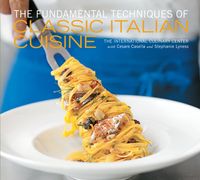Advertisement
Appears in
The technique discussed below is used when making Polenta.
Polenta was traditionally made in an unlined copper pot called a paiolo that hung over the fireplace. A heavy-bottomed pot makes an excellent modern substitute.
In order to prevent lumps, polenta is started in cold water with a little olive oil, whisking often. As the water comes to a simmer, the polenta thickens. The mixture is cooked slowly, stirring often with a wooden spoon, until the polenta pulls away from the sides of the pan, is free of lumps, and has the consistency of soft mashed potatoes, with a silky texture resulting from the release of the cornstarch. Unlike risotto, polenta need not be stirred constantly—a stir every now and then with a wooden spoon is adequate.

